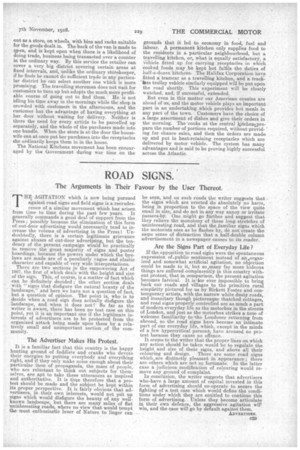ROAD SIGNS.
Page 9

If you've noticed an error in this article please click here to report it so we can fix it.
The Arguments in Their Favour by the User Thereof.
TH,. AGITATION which is now being pursued against road signs and field signs is a recrudescence of a similar movement which has arisen from time to time during the past few years. It generally commands a good deal of support from the Press ; possibly because the elimination of this form of out-door advertising would necessarily tend to increase the volume of advertising in the Press! Undoubtedly, there is a certain legitimate grievance against abuses of out-door advertising, but the tendency of the present campaign would be practically to remove the great majority of signs and poster hoardings, because the powers under which the byelaws are made are of a peculiarly vague and elastic character and capable of very wide interpretations. There are two sections in the empowering Act of 1907. the first of which deals with the height and size of the sign. This, of course, is a matter of fact which can be definitely decided ; the other section deals with "signs that disfigure the natural beauty of the landscape," and here we have not a question of fact, but a question of opinion. The point is, who is to decide when a road sign does actually disfigure the landscape, and when it does not }3o far as the writer is aware, there has been no test case on this point, yet it is an important one if the legitimate interests of advertisers are to be protected from the organized attack being made upon them by a relatively small and unimportant section of the community.
The Advertiser Makes His Protest.
It is a familiar fact that this country is the happy hunting ground of faddists and cranks who devote their energies to putting everybody and everything right, and if they only make noise enough about their particular item of propaganda, the mass of people, who are reluctant to think out subjects for themselves, are apt to take these utterances as inspired and authoritative. It is tinrie therefore that a, protest should be made and the subject be kept within its proper perspective. It is fairly obvious that ad vertisers. n t interests, own would not put up signs whi in would disfigure the beauty ofany wellknown landscape, but there are many miles of flat uninteresting roads, where no view that would tempt the most enthusiastic lover of Nature to linger can be seen, 'and on such roads the writer suggests that the signs which are erected do absolutely no harm, being in proportion to the space of the view quite small in size, and do not in any way annoy or irritate passers-by. One might go further and suggest that they relieve the monotony of these long. stretches of uninteresting road, and that the familiar signs which the motorists sees as he flashes by, do not create the same sense of distraction that a half-double column advertisement in a newspaper causes to its reader.
Are the Signs Part of Everyday Life ?
If the opposition to road sigias were the spontaneous expression of.publio sentiment instead of an„organized and somewhat artificial agitation, no objection could be made to it, but so,many far more hideous things are suffered complacently in this country, without protest, that in comparison, the present agitation becomes farcical. It is ior ever impossible to bring back our roads and villages to the primitive rural simplicity pictured for us by Birkett Foster and contemporary artists, with the narrow white dusty roads, insanitary nsanitary though picturesque thatched cottages, and road signs-properly controlled are as much a part of modern everyday life as the motorbus in the streets of London, and just as the motorbus strikes a note of welcome familiarity. to ,the Londoner returning from abroad, so the road signs have become an intimate part of our everyday life, which, except in the minds of a few hypercritical persona, have aroused no protest 'because they cause no offence.
It seems to the writer that the proper lines on which any action should be taken would be to regulate the height and size of these signs, and above all their colouring and design. There are some road signs which,are distinctly pleasant in appearance ; there are others which are not so fortunate. In the latter case a judicious modification of colouring would remove any ground of complaint. In conclusion, the writer suggests that advertisers who,have a large amount of capital invested in this form of advertising should co-operate to secure the fighting of a test case which would define the conditions under which they are entitled to continue this form of advertising. Unless they become articulate in their own defence, the aggressive agitation wiP win, and the case will go by default against them. AnvaaTisza. 029






















